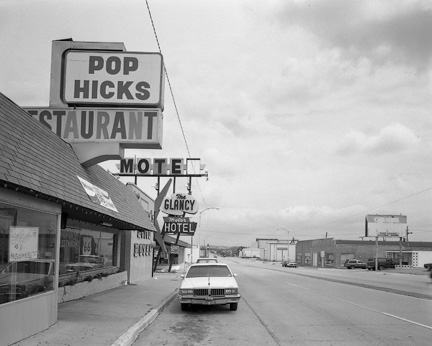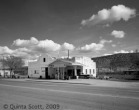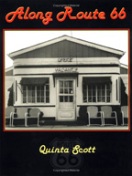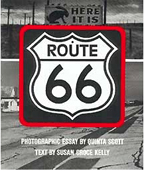West of Rolla, Missouri 66 plunged into the Ozarks and into a vernacular architecture that was unique to the region, but shows up in the Rock Cafe. Ozark proprietors built stone cottages and log cabins using the local materials–oak logs cut from the forests and warm, rusty, Ozark sandstone cut from the hills. Slabstone or “giraffe-stone” construction was developed in the Teens and the Twenties in Thayer, Missouri near the Arkansas border, and carried north to Rolla. “Rock men” set flat slabs of sandstone on a concrete foundation and laid up stone as a veneer over a wood frame or a concrete wall. In Ozark lingo, they “rocked” the building.

- Gascozark Cafe and Gas Station, Gascozark, Missouri
Frank A. Jones, who made his living from the Gasconade River and the Ozark Hills, coined the name “Gascozark.”
He operated a resort down on the river, and the Gascozark Cafe and Gas Station up on the hill above the river. In 1931 he bought a small building on the hill and added on to it. When he finished, he had several simple stucco buildings knitted together with an uneven roof line.
Four years later he hired Mr. Lillard, a rock man, “to rock the building.” Lillard wrapped a veneer of large, flat Ozark stones around the front and the sides of the building, using small stones to fill the gaps between the large stones. To even out the roof line, he shaped an arch that spanned the facade and finished it with round cobbles, rolled smooth by the river. At the corners he piled up columns of rubble and mounted lanterns on top.

Rock Cafe, Stroud, Oklahoma, 1939
As 66 approached Oklahoma City, it passed through the eastern edge of the Sandstone Hills, which extend to the western edge of the state. The soft, red sandstone, buried under the rolling hills, gives Oklahoma soil and an occasional roadside building, its distinctive color.
When highway engineers cut U.S. 66 through a layer of sandstone near Kellyville, they sold the discarded rock to Roy Rieves for five dollars. Rieves carted it to a site on the eastern outskirts of Stroud, and constructed the Rock Cafe, a one story building with very tall ceilings.
Unlike the “rock folk” in Missouri who laid up slabs of sandstone as a veneer against a frame building, Rieves used masonry construction, laying his hunks of rock, varying from light yellow through red to almost black, on a concrete foundation. At the corners of the building, Rieves carefully set horizontal stones to build columns that projected through the roof. He took the same care with the fireplace and chimney. In between, he laid the stones every which way. When he finished, he topped the building with a hat-like tin roof pulled down low. He painted roof green and stated the cafe’s speciality: Bar-B-Que, punctuated with the round face of a fat pig.
The cafe is listed on the National Register of Historic Places.

Pop Hicks and the Glancy Motel, Clinton, Oklhoma
Fire damaged the cafe on May 20, 2008. Its owner, Dawn Welsh, rebuilt and reopened last week, saving it from the fate of another iconic Clinton, Oklahoma eatery, Pop Hicks, which burned down on August 2, 1999.
Ethan “Pop” Hicks–who started with a three booth, seven stool diner, and a lean-to kitchen in 1936–built right up against the street.
On the morning of August 2, a fire, probably electrical, broke out in the back room of Pop Hicks, a restaurant that had been thriving on the myth of Route 66. That afternoon, page one of the Clinton Daily News reported that what started as a small fire, quickly grew into a big fire, and Pop Hicks burned to the ground. No more than three feet to the east, one wing of the Glancy Motel suffered only minor smoke and water damage.
Motel owners like Chester and Gladys Glancy jammed as many units as possible on a narrow site.
The Glancys married in 1925, farmed for a year down the road at Foss, and then moved to Clinton where they ran simultaneously and successively a carnival, a restaurant, a fruit stand, a grocery, and a filling station.
When Chester realized that local motel owners took in more cash in one night then he could in a week with all his businesses, they rented the Clinton Courts south of town. They built the Glancy in 1939. They picked the site because it was next door to Pop Hicks. When they enlarged it in 1948, they responded to mounting competition with an imperative arrow on a bigger, taller, gaudier sign that hung out over the street. Before they retired, the Glancys built a small regional chain in western Oklahoma with motels in Oklahoma City, Weatherford, and Elk City.
Filed under: Fine Art Photography, Quinta Scott, Route 66 Photographs | Tagged: Gascozark, Giraffe Stone Architecture, Pop Hicks, Rock Cafe, Slabstone Architecture | 2 Comments »




